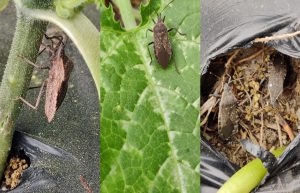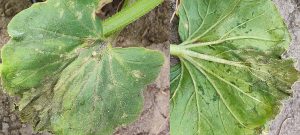As you could guess from the name, the squash bug, Anasa tristis, is a pest of squash and all other relatives of squash. The squash bug is common in the United States, especially in areas where these crops are grown. In Florida, several generations of the squash bug may occur during the crop season due to our warmer temperatures and host availability. People often confuse the squash bug with stink bugs. Although they are related, the squash bug is different from the stink bugs.

Squash, pumpkin, and zucchini are generally more attractive to the squash bug than watermelon. Despite this preference, an increasing number of reports of this pest in watermelon have occurred within the last several years.
Squash bug causes the plants to become sick by sucking up juices from the leaves, vines, and sometimes, the fruits. Such feeding action could result in pronounced damage leading to wilting, fruit rot, and death.

So, if you plan to include summer and winter squash, pumpkins, or watermelon on your list of vegetables for your garden, be prepared for squash bugs as they might come visiting. That way, you could keep your crops safe this bug.
Adults and nymphs of the squash bug seek shelter underneath leaves or under the plastic cover, quickly find a place to hide when disturbed.
Because the squash bug prefers crops like Blue Hubbard Squash and zucchini, these crops may be used to ‘trap’ and ‘distract’ them from the primary crop such as cantaloupes, watermelon or cucumbers.
The evaluation of Blue Hubbard squash and zucchini as traps for the squash bug is part of an ongoing research at the University of Florida. These trap crops are planted a few weeks earlier than the main crop, and they are regularly treated or removed to prevent a build-up of the population. If you want more information about this ongoing research, please contact the author.
Check out our UF entomology and Nematology Feature Creatures article for details about the squash bug.
I acknowledge Robert C. Hochmuth and Warren W. Mark for providing the pictures in the featured image. I also acknowledge Dr. Amanda Hodges for the insightful contribution.
 0
0
